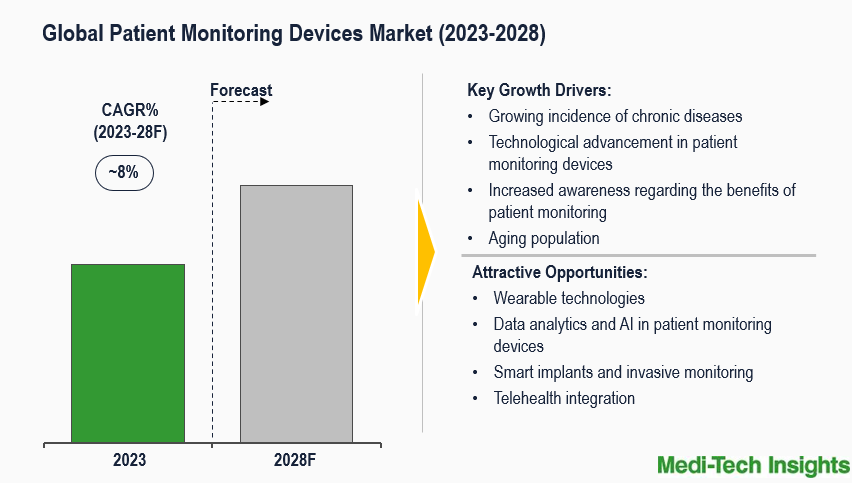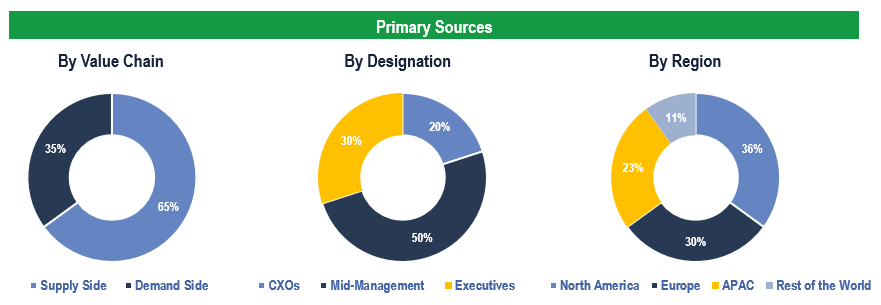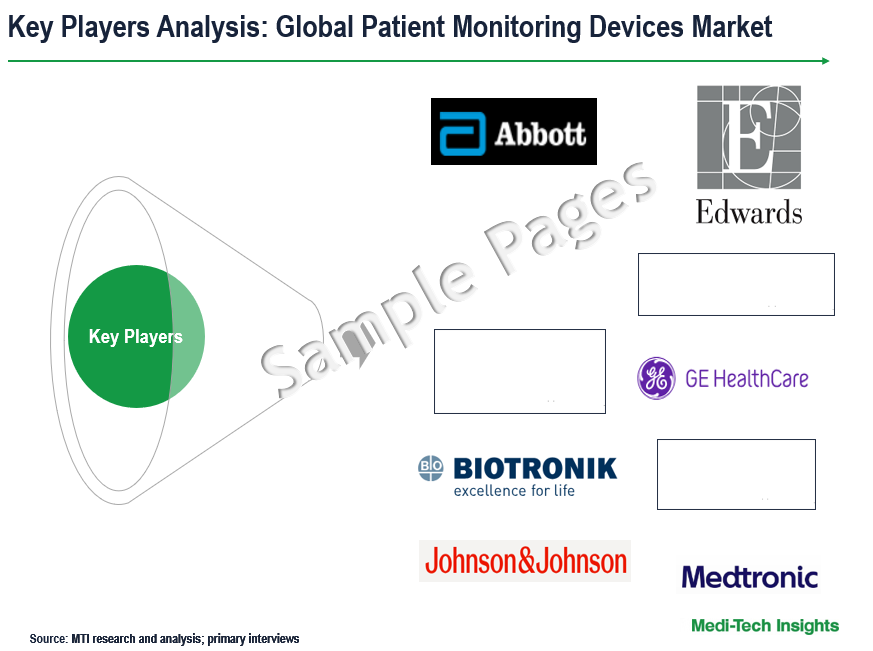
Global Patient Monitoring Devices Market Projections Indicate a Strong ~8% Growth by 2028
The Global Patient Monitoring Devices Market is expected to grow at ~8% by 2028. The rising prevalence of chronic diseases, the growing aging population, the increasing adoption of remote patient monitoring devices, and technological advancements in patient monitoring devices are some of the key factors driving the global patient monitoring devices market. To learn more about the research report, fill out a quick inquiry for a sample report.
Patient monitoring devices refer to medical instruments employed for observing and recording a patient's vital signs, including heart rate, blood pressure, and respiratory rate. These devices find applications in diverse settings, encompassing hospitals, clinics, and residences. Their role extends to enhancing patient care by signaling early signs of potential health issues and aiding in the assessment of treatment effectiveness. Patient monitoring devices are broadly classified into the following types:
- Hemodynamic Monitoring Devices: These devices assess and record the dynamics of blood circulation, providing crucial insights into cardiac function and circulatory status
- Neuromonitoring Devices: These devices are utilized to observe and measure neurological parameters, such as brain activity, to monitor and ensure the health of the nervous system during surgical or critical care procedures
- Cardiac Monitoring Devices: These are specialized devices focused on tracking and recording the electrical and mechanical activities of the heart, aiding in the diagnosis and management of cardiac conditions
- Multi-parameter Monitors: These are versatile devices capable of monitoring various physiological parameters simultaneously, including heart rate, blood pressure, and oxygen saturation, providing comprehensive patient data
- Respiratory Monitoring Devices: These devices are designed to monitor and analyze respiratory parameters, such as breathing rate and oxygen levels, crucial for managing respiratory conditions and ensuring adequate ventilation
- Remote Patient Monitoring Devices: These devices utilize technology to monitor patients outside traditional healthcare settings. They facilitate continuous tracking of vital signs, enhancing healthcare delivery and patient outcomes
Increasing Demand for Patient Monitoring Devices in Non-Hospital Settings Drives the Market
There has been a notable uptick in the adoption of patient monitoring devices outside of the hospital environment, encompassing usage in homes and long-term care facilities. These devices play a pivotal role in enabling healthcare professionals to continuously track a patient's condition, facilitating prompt interventions in response to any changes. These devices help in improving patient outcomes and reducing the need for hospitalization. Hospital stays can be expensive and add to the overall healthcare cost. However, the use of patient monitoring devices can help in reducing the need for hospitalization, thereby reducing healthcare costs. Patient monitoring devices not only benefit patient care but also foster more effective communication among healthcare professionals and between healthcare providers and patients. These devices routinely transmit data to healthcare providers, allowing for swift reviews and formulation of more effective treatment strategies. Due to the advantages offered by patient monitoring devices, there has been a significant increase in the utilization of these devices in non-hospital settings.

Fill out the "Quick Inquiry Form" to request a sample copy.
Technological Advancement in Patient Care Using Wearables, AI (Artificial Intelligence), and Mobile Health Devices Boost the Market
Technological advancements in patient monitoring devices have been transformative, leading to more accurate, efficient, and patient-centric healthcare solutions. These innovations have played a pivotal role in providing healthcare professionals with real-time insights and patients with more personalized and proactive care. Some recent advances in patient monitoring devices are as follows:
- Telemonitoring: Remote Patient Monitoring (RPM) or Telehealth is a type of ambulatory healthcare that helps patients and doctors use mobile medical devices to track vitals and analyze data in real-time. RPM enhances patient outcomes by facilitating continuous monitoring and timely interventions, reducing the need for frequent hospital visits, and improving overall healthcare accessibility. For instance,
- In January 2023, - Senet and Telli Health, announced the launch of the first remote patient monitoring (RPM) hardware powered by LoRaWAN. The technology allows providers to reach more patients in remote and underserved areas - such as indigenous communities worldwide - boosting healthcare equity and inclusivity and creating the foundation to provide more smart home services shortly
- Wearable Technology: Wearable technology has become a valuable tool for managing patient conditions and gathering real-time data, whether in routine healthcare monitoring or decentralized clinical trials. Wearable devices equipped with miniaturized sensors allow continuous monitoring of vital signs, such as heart rate, blood pressure, and oxygen levels. For instance,
-
- In May 2022, Shenzhen Mindray Bio-Medical Electronics Co., Ltd. announced the launch of mWear, a new wearable patient monitoring device. The device offers two monitoring options—wearable mode and continuous mode so that caregivers can receive patient status updates following customized settings
- Artificial Intelligence and Machine Learning: Artificial intelligence and machine learning are being increasingly used in patient monitoring systems to analyze data and identify patterns that can help healthcare professionals make more informed decisions about patient care
- Mobile Health: Employing remote medical diagnosis and monitoring systems based on mobile health systems helps significantly to reduce health care costs, and optimal performance management, particularly in chronic disease management
Key Constraints/Challenges
In the patient monitoring devices market, meeting increasingly stringent regulatory requirements is a significant challenge. Regulatory bodies worldwide consistently update their standards to ensure the safety and efficacy of patient monitoring devices. Keeping pace with these evolving requirements poses challenges for manufacturers, potentially causing delays in the development and release of new devices. Another obstacle in the patient monitoring devices market pertains to managing vast amounts of data. These devices generate substantial data that must be securely collected, stored, and analyzed in a manner that ensures both security and accessibility. This undertaking is intricate, and costly, and presents the additional challenge of deriving meaningful insights from the data.
North America Holds the Largest Share in the Global Patient Monitoring Device Market
North America currently holds a major share of the global patient monitoring device market. This can be mainly attributed to the growing prevalence of chronic diseases, decent penetration of advanced technology, and the growing demand for wireless and portable systems in the region. However, APAC is expected to witness the strongest growth in the forecasted period due to an increase in chronic medical conditions, the growing adoption of technologically advanced patient monitoring devices, and a high number of geriatric populations in the region.
Competitive Landscape
Some of the key players operating in the market include Abbott Laboratories, Hill-Rom Holdings, Inc., Drägerwerk AG & Co. KGaA, Edwards Lifesciences Corporation, OMRON Corporation, Masimo Corporation, Shenzhen Mindray Bio-Medical Electronics Co., Ltd., Nihon Kohden Corporation, Natus Medical, Medtronic plc, Koninklijke Philips N.V., GE Healthcare, Johnson and Johnson, Dexcom, Inc., BIOTRONIK, BioTelemetry, Inc., Getinge AB, Boston Scientific Corporation, among others.
Organic and Inorganic Growth Strategies Adopted by Players to Establish Their Foothold in the Market
Players operating in this market are adopting organic and inorganic growth strategies such as launching new products, acquiring related firms, and entering into collaborations to garner higher market share. For instance,
- In April 2023, GE HealthCare announced US FDA 510(k) clearance of its CARESCAPE Canvas patient monitoring platform for precise, flexible patient care
- In March 2023, Alio, Inc., and Carium announced that they have entered into a partnership that will be focused on improving health outcomes for patients with chronic conditions and increasing healthcare accessibility through Alio's remote patient monitoring platform
The patient monitoring devices market is a complex and rapidly evolving industry that is expected to gain further momentum in the coming years due to the availability of a wide variety of devices and technologies, a strong emphasis on developing new products, and aggressive organic and inorganic growth strategies followed by the players.
Key Strategic Questions Addressed
- What is the market size and forecast for the Patient Monitoring Devices Market?
- What are the historical, present, and forecasted market shares and growth rates of various segments and sub-segments of the Patient Monitoring Devices Market?
- What are the major growth drivers, restraints/challenges impacting the market?
- What are the opportunities prevailing in the market?
- What is the investment landscape?
- Which region has the highest share in the market? Which region is expected to witness the highest growth rate in the next 5 years?
- Who are the major players operating in the market? What is the competitive positioning of key players?
- Who are the new players entering the market?
- What are the key strategies adopted by players?
- Research Methodology
- Secondary Research
- Primary Research
- Market Estimation
- Market Forecasting
- Executive Summary
- Market Overview
- Market Dynamics
- Drivers
- Restraints
- Opportunities
- Industry Speaks
- Market Dynamics
- Global Patient Monitoring Devices Market - Size & Forecast (2021-2028), By Product
- Hemodynamic/Pressure Monitoring Devices
- Neuromonitoring Devices
- Cardiac Monitoring Devices
- Multi-Parameter Monitors Devices
- Respiratory Monitoring Devices
- Blood Glucose Monitoring Systems
- Temperature Monitoring Devices
- Fetal & Neonatal Monitoring Devices
- Weight Monitoring Devices
- Other Types of Devices
- Global Patient Monitoring Devices Market - Size & Forecast (2021-2028), By End-User
- Home Care Settings
- Hospitals
- Ambulatory Surgery Centers
- Other End-Users
- Global Patient Monitoring Devices Market - Size & Forecast (2021-2028), By Region
- North America (U.S. & Canada)
- Europe (UK, Germany, France, Italy, Spain, Rest of Europe)
- Asia Pacific (China, India, Japan, Rest of Asia Pacific)
- Rest of the World (Latin America, Middle East & Africa)
- Competitive Landscape
- Key Players and their Competitive Positioning
- Competitive Positioning of Key Players (2022)
- Offerings Assessment, By Players
- Key Strategies Assessment, By Player (2021-2023)
- New Product and Service Launches
- Partnerships, Agreements, & Collaborations
- Mergers & Acquisitions
- Other Developments
- Key Players and their Competitive Positioning
- Key Companies Scanned (Indicative List)
- Abbott Laboratories
- Hill-Rom Holdings, Inc.
- Dragerwerk AG & Co. KGaA
- Edward Lifesciences Corporation
- Masimo Corporation
- Johnson & Johnson
- Medtronic PLC
- GE Healthcare
- Omron Corporation
- Getinge AB
- Boston Scientific Corporation
- Nihon Kohden Corporation
- Shenzhen Mindray Bio-Medical Electronics Co., Ltd.
- Natus Medical
- Koninklijke Philips N.V.
- Dexcom, Inc.
- BIOTRONIK
- Other Prominent Players
The study has been compiled based on extensive primary and secondary research.
Secondary Research (Indicative List)

Primary Research
To validate research findings (market size & forecasts, market segmentation, market dynamics, competitive landscape, key industry trends, etc.), extensive primary interviews were conducted with both supply and demand-side stakeholders.
Supply Side Stakeholders:
- Senior Management Level: CEOs, Presidents, Vice-Presidents, Directors, Chief Technology Officers, Chief Commercial Officers
- Mid-Management Level: Product Managers, Sales Managers, Brand Managers, Business Development Managers, Consultants
Demand Side Stakeholders: Hospitals, Home Care Settings, and Ambulatory Surgery Centres, among others
Breakdown of Primary Interviews

Market Size Estimation
Both ‘Top-Down and Bottom-Up Approaches’ were used to derive market size estimates and forecasts.
Data Triangulation
Research findings derived through secondary sources & and internal analysis were validated with Primary Interviews, Internal Knowledge Repository, and Company Sales Data.



